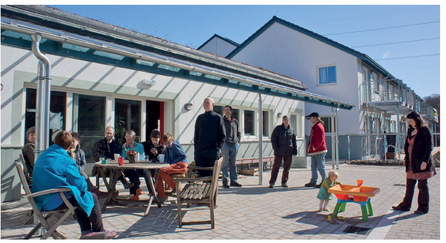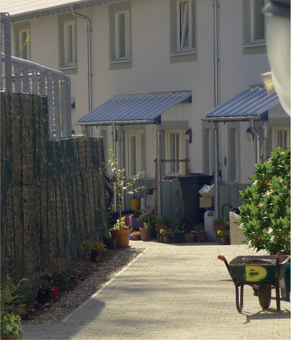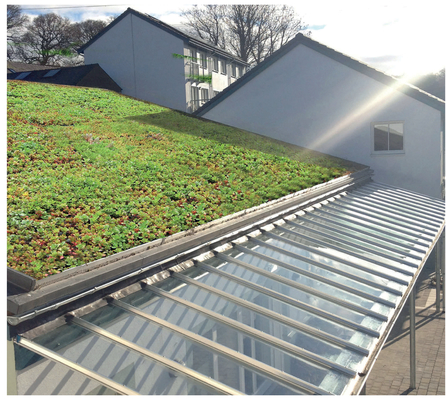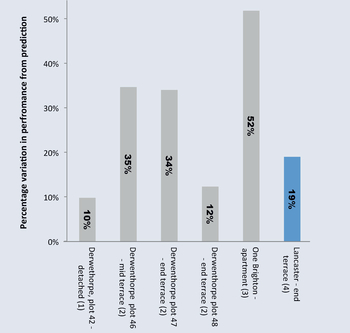CASE STUDY 10
Forgebank–Lancaster Co-housing
Halton

Overview
The five founders of the Lancaster Co-housing project first looked for a suitable development site in 2006, and after a long search settled on an idyllic position next to the River Lune. The aim was to develop a community of like-minded enthusiasts who would pledge funds to purchase land, secure planning and collaborate in the development of a sustainable living environment. The original intention was to find a site in Lancaster to make car-free living possible; the chosen site, three miles from town, is a little further out than had been hoped for.
The sloping brownfield site on the northern bank of the river suggested the creation of compact terraces of houses with living rooms facing south, towards the view, and with extensive south-facing roof areas for photovoltaic (PV) panels (Figure 01). A 160kW community-owned hydro-turbine has also been installed at the eastern end of the site, making the scheme a net exporter of energy. Heating and hot water is provided via a district-heating system fuelled by a biomass boiler.




02 Forgebank, Halton
Design approach
The designs for the houses themselves evolved through a participatory process, guided by experienced Passivhaus designers, Eco Arc Architects, and project managed by one of the co-housing group founders. Several of the people who joined the project had been pioneers in some aspect of ecological or community living, and wanted to learn from living together and to share their learning with a wider audience. Despite the abundance of renewable energy, the project aimed to reduce the energy used in the buildings to a practical minimum, and to increase their longevity in order to reduce the impact of embodied energy.
The time spent with designers Eco Arc Architects developing the brief and the layout of the homes has clearly been rewarded. Although it was a drawnout process (decisions taken by the co-housing members are reached by consensus) the end result has lived up to expectations. The homes are small, but some space-consuming activities have been taken out of individual dwellings and planned into communal areas.

03 External view from the eastern end of the scheme

04 Communal space outside the shared common room

05 The car-free street

06 External view
There is a large bicycle store, communal guest rooms, a common house for shared meals and a communal laundry (Figures 03 and 04). Some communal parking is provided but car ownership is discouraged and, as a result, the layout feels compact and neighbourly, with a pedestrian street, footpaths and riverside terraces in place of tarmac kerbs and parking areas (Figures 05 and 06).


08 ‘Living’ roofs
Environmental design
Committing to the Passivhaus standard and to post-construction certification was an ambitious target for a scheme of this scale, and although the specialist resources of experienced Passivhaus consultants and suppliers were available the contractor had the daunting task of educating and enthusing an inexperienced group of subcontractors. The main contractor joined the project team at an early stage, having been appointed through a two-stage partnering contract that set out to guarantee the final cost. Decisions on cost and buildability were confronted at an early stage, leading to some spatial simplification of the houses (the loss of ‘cathedral’ ceilings on some dwellings) but also helping to manage expectations of what could be achieved within the fixed budget (Figure 09).
Forgebank has been studied in two rounds of the Innovate UK programme. Thermography and co-heating tests were undertaken by Leeds Beckett University, and the Building User Studies (BUS) survey was conducted by Sheffield University. Further long-term evaluation is under way with York University’s Housing Unit and the Stockholm Institute. The BUS survey showed one of the highest satisfaction levels of any housing scheme visited by the researchers, with residents liking most aspects of the project but particularly the setting and outlook of the homes, and the comfort levels and low running costs.
The work by Leeds Beckett on the building fabric revealed some gaps in insulation, especially around the roof eaves and above ceilings, and some air leakage at the mitred joints of the window frames. The contractor was appointed in a two-stage tender and embraced the challenge of delivering the Passivhaus standard. Airtightness levels averaged 0.4 m3/h.m2 @50Pa, an improvement on the extremely demanding Passivhaus target of 0.6 m3/h.m2 @50Pa. However, there was a constant challenge to bring all of the subcontractors up to the same level of understanding and competence to deliver the necessary construction quality. The role of airtightness champion was elevated to one of all-round educator and quality monitor (Figures 11–12).
A co-heating test was carried out in January 2013 on an end-terrace 65m2 dwelling. The test is used to measure the heat-loss coefficient for the dwelling fabric (effectively a whole-house U-value) and relies on being able to establish an elevated and stable internal temperature in an unoccupied dwelling for a continuous period of weeks. When this stable temperature is maintained (typically 15–20°C above external temperature) the dwelling will have reached a good approximation of steady-state heat loss. A measurement of the energy required to maintain this temperature, with corrections for external conditions, is then used to derive a heat-loss coefficient.
Unfortunately the research team did not have control of the adjacent dwelling, which in normal test conditions would be maintained at the same elevated temperature as the test dwelling, to discount heat loss through the party wall. It is likely that there will have been some heat transfer to the adjacent occupied home.
During the test it also proved harder to maintain a constant internal temperature compared with typical dwellings, as periods of high solar insolation caused rapid temperature rises in the south-facing rooms, of up to 5°C above the target temperature. The research team used techniques to
discount these solar heating effects in the data analysis, but the Lancaster test highlights the complexity of accurate measurement in such highly insulated and airtight homes. The large contribution to internal temperature from solar gains is in itself a demonstration of Passivhaus principles in operation.

09 Section through three-bed house (upstairs living) with ‘cathedral’ ceiling
Apart from the minor deviations from the ideal test procedure the test results were among the best of the Leeds Beckett data sample, with only a marginal difference between the predicted heat loss and the measured data (see Figure 14, co-efficient of heat loss graph).

10 Cavity wall window head

11 Cavity wall window cill

12 Cavity wall ground floor to wall junction
Monitoring and post-occupancy feedback
For most of the residents, living in a Passivhaus will have been a new experience, but fortunately for the group a number of members had building and project management expertise that included some familiarity with Passivhaus. Experiences of running the homes are shared and high levels of support provided for all the members by the volunteers with building-services experience. Filter changing in the mechanical ventilation with heat recovery (MVHR) units is organised by one group member, with a bulk order of filters arriving twice a year from the Green Building Store, which supplied the German MVHR units. The ventilation controller has a calendar-type indicator counting down to the next filter change, but no warning that a filter may have become blocked is provided by the system. This is the only minor criticism of the otherwise well thought-out and usable ventilation controls.
Until quite recently whole-house ventilation systems were rare in the UK, but a rapid uptake in mainstream housing has prompted concerns about the industry’s ability to design, install and commission such systems (see NHBC Foundation report NF 52).113 In the UK market there are plenty of low-specification ‘rebadged’ products but the demand for high-performance equipment (essential for Passivhaus operation) is low, leading to some frustrations – there was no English language technical or user manual for the Forgebank units, and filters are relatively expensive compared with prices in mainland Europe. (The literature problem was overcome by the support team at the Green Building Store, and German-speaking co-housing members.) The group engaged experienced Passivhaus designers at the outset, helping to ensure that the ventilation system was carefully designed, minimising pressure losses with short duct lengths and planning the position of outlets and return air grilles carefully – but most importantly, there was no cutting corners on the specification of the units. Some minor lifestyle adjustments have been necessary at Forgebank. Some residents have had to stop using candles and tea lights, which after some investigation were proven to be the cause of premature filter contamination. Many respondents in the BUS survey noted a drier air quality, compared to their previous homes,114 though this was not perceived to be problematic, and where limited monitoring has been done internal conditions have been shown to be near optimal for internal humidity. In the future strategies may be required for dealing with summer overheating – although there are extensive balcony shades the MVHR unit does not have a summer bypass – using the windows for purge ventilation and internal blinds to provide some shading in the living space (Figure 13).

13 External view: balconies shade south-facing living rooms
Conclusions
As with other Innovate UK projects that have measured well and showed high levels of user satisfaction, there is a demonstrable link between the commitment of the client team in devising the brief and developing the design, and the continuation of that commitment through the construction team. At Forgebank a conscientious and skilled contractor maintained the project objectives from first procurement through to handover. When the scheme was completed it was one of the largest certified Passivhaus projects in Europe. Passivhaus, through its design protocol (Passivhaus Planning Package, or PHPP) and accreditation of products and components, embeds quality standards and controls. But it is a demanding standard to execute for our building culture, which has embraced a plethora of design standards and targets but has not been focused on outcomes and measured quality. Forgebank is a frequently visited exemplar, and offers monthly tours. The account of the detailing and construction of Forgebank published in Green Building magazine between Winter 2011 and Spring 2013115 holds many insights and lessons for the aspiring low-energy neighbourhood or community.

14 Coefficient heat-loss graph

15 Percentage variation in performance graph
